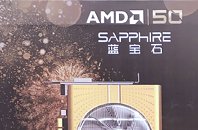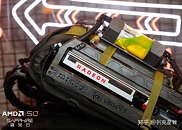Tuesday, May 21st 2019

Sapphire Reps Leak Juicy Details on AMD Radeon Navi
A Sapphire product manager and PR director, speaking to the Chinese press spilled the beans on AMD's upcoming Radeon Navi graphics card lineup. It looks like with Navi, AMD is targeting the meat of the serious gamer market, at two specific price points, USD $399 with a "Pro" (cut-down) product, and $499 with an "XT" (fully-fledged) product. AMD has two NVIDIA products in its crosshairs, the GeForce RTX 2070, and the RTX 2060. In the interview, the Sapphire rep mentioned "stronger than 2070", when talking about performance numbers, which we assume is for the Navi XT variant - definitely promising. The $399 Navi "Pro" is probably being designed with a performance target somewhere between the RTX 2060 and RTX 2070, so you typically pay $50 more than you would for an RTX 2060, for noticeably higher performance.
Sapphire also confirmed that AMD's Navi does not have specialized ray-tracing hardware on the silicon, but such technology will debut with "next year's new architecture". They also suggested that AMD is unlikely to scale up Navi for the enthusiast segment, and that the Vega-based Radeon VII will continue to be the company's flagship product. On the topic of Radeon VII custom designs, Sapphire commented that "there is no plans for that". On the other hand, Sapphire is actively working on custom designs for the Navi architecture, and mentioned that "work on a "Toxic" version of Navi is complete, and it is watercooled". Many people have speculated that AMD will unveil Navi at its Computex keynote address on May 27. Sapphire confirmed that date, and also added that the launch will be on 7th of July, 2019.
Source:
Zhihu (Blog)
Sapphire also confirmed that AMD's Navi does not have specialized ray-tracing hardware on the silicon, but such technology will debut with "next year's new architecture". They also suggested that AMD is unlikely to scale up Navi for the enthusiast segment, and that the Vega-based Radeon VII will continue to be the company's flagship product. On the topic of Radeon VII custom designs, Sapphire commented that "there is no plans for that". On the other hand, Sapphire is actively working on custom designs for the Navi architecture, and mentioned that "work on a "Toxic" version of Navi is complete, and it is watercooled". Many people have speculated that AMD will unveil Navi at its Computex keynote address on May 27. Sapphire confirmed that date, and also added that the launch will be on 7th of July, 2019.


119 Comments on Sapphire Reps Leak Juicy Details on AMD Radeon Navi
Let's say the "Pro" is right in the middle between RTX2060 and RTX2070 and "XT" is 10% over RTX2070 then It would look like this:
(Performance was calculated based on Performance summary in 4K from this review: www.techpowerup.com/reviews/EVGA/GTX_1650_SC_Ultra_Black/27.html)
RX 570 4GB - 52% ($130) -> 159% price/performance ratio
GTX 1060 6GB -59.5% ($200) -> 118% price/performance ratio
RX 580 8GB - 62% ($190) -> 130% price/performance ratio
RX 590 8GB - 69% ($220) -> 124% price/performance ratio
GTX 1660 6GB - 70.5% ($220) -> 127% price/performance ratio
GTX 1660Ti 6GB - 81% ($280) -> 115% price/performance ratio
Vega 56 8GB - 93% ($320) -> 115% price/performance ratio
RTX 2060 6GB - 100% ($350) -> 113% price/performance ratio
Vega 64 8GB - 103.5% ($400) -> 103% price/performance ratio
Navi "Pro" 8GB - 110.5% ($399) -> 110% price/performance ratio
RTX 2070 8GB - 121% ($480) -> 100% price/performance ratio
Navi "XT" 8GB - 133% ($499) -> 106% price/performance ratio
Turing was criticized because of Its price/performance ratio and now look at this. If the performance and price is correct then It doesn't look good for Navi. I am not sure If It's a successor to Vega or to Polaris or to both, but Polaris is much better and even Vega 56 has a bit better performance/price ratio.
*For now, at least - we'll see in 2-3 years if RTRT catches on.Uhm, no. It's a core architecture, which AMD has iterated on since they abandoned the previous TeraScale architecture. There are many variants, but they share a core framework and a lot of functionality. No GCN variant is fundamentally different from any other - just improved upon, added features to, etc. That's why AMD's early GCN cards have had such excellent longevity.
and I don't see those drastic differences. Little additions and resources reshuffling, yes, but nothing more.
static.techspot.com/articles-info/1791/bench/2080.png
Power-hungry? Check rumours and check real power consumption of Vega. Green fanboy.
They have the Gaming Consoles, Game Streaming (MS/Google), and will try to catch as much market possible with APU's for low end graphic and up until Vega64 performance level with competitive Navi cards, isn't it most of the market?
Sapphire usually has excellent air cooling solutions, their tri-fan cards are legendary.
If they need to water cool it may mean out of control power consumption.
static.techspot.com/articles-info/1789/bench/Power.png
So why can't It be called as power hungry?
Check rumours... :slap: that's all we ever do isn't it, until the product is released and most of it gets confirmed.
Sapphire has no tradition in WC cards; their forte is triple fans.
They may have chosen to go water, or they may have been forced to.
Or they dont run cool?
Please don't misread me, I'm not being fanboish, I'm just calling attention for a detail that may be significant.
Because surely you have noticed there's a dearth of water cooled RX 560 or GTX 1030 cards.
Yes, its possible to air cool 300W just fine on a PCIe slot form factor.
Yes, WC might do it with less surface area and with a lower maximum temp under load, at a higher build cost and higher failrate.
The reason you see WC on a 1070 was because AIOs are all the rage for some and the midrange can be sold at premium. They sell. The reason you saw it on the Fury X was because AMD considered it the best option given the tradeoff to an air cooler (bulky/weight wise, even despite the higher cost) - so that dóes indicate that WC was related to high power consumption. Then, with Radeon VII they showed us that they can do the air option just fine as well with a large triplefan setup- and its likely cost played a major role here because the margin on that card isn't great.
The reason we don't see WC on low-end is because there is no way you will sell budget cards at premium price.